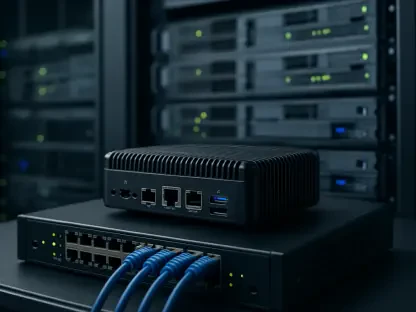The rapid evolution of artificial intelligence has brought to the forefront a critical need for advanced networking technologies capable of tackling the immense data handling requirements of modern AI models. Traditional networking structures such as Ethernet and InfiniBand, although instrumental in the past, were not built with the massive parallel processing and instantaneous data exchange demands of today’s AI applications in mind. Enter Cornelis Networks with their revolutionary CN500 fabric, poised to redefine the way data centers operate by introducing a network architecture that significantly boosts communication speeds, aiming for a potential six-fold increase compared to conventional methods. As AI continues to advance, with models growing ever more complex and data-intensive, the role of efficient and robust networking solutions becomes ever more crucial. Cornelis Networks’ innovative approach with the CN500 is not just about speed but also ensuring minimal latency and seamless operations across expansive computational frameworks, essential for training AI models and conducting high-throughput simulations.
Shifting Networking Paradigms for AI
The CN500 fabric by Cornelis Networks signifies a major shift from traditional networking paradigms, transitioning from designs meant for limited local computer connections to robust architectures that support large-scale AI operations efficiently. Traditional Ethernet and InfiniBand systems, while foundational, now face challenges in managing the vast data exchanges needed for cutting-edge AI applications. This is particularly evident in the realm of parallel computing, where coordinating thousands of nodes without lag is vital. Cornelis Networks addresses this demand through their cutting-edge networking technology, tailored to support up to 500,000 computers with minimal latency issues. This is crucial for AI models that involve real-time simulations and data processing across distributed systems. The CN500 fabric’s ability to maintain optimal throughput without losing data packets ensures continuous, interruption-free operations, setting a new standard in AI and high-performance computing (HPC) capabilities. This advancement highlights the shift towards more sophisticated and efficient methods that naturally integrate within the existing AI ecosystems.
One of the key aspects of Cornelis Networks’ approach is their Omni-Path architecture, originally developed by Intel, now tailored to modern AI needs. By fundamentally restructuring how data is communicated across massive networks, this innovation offers a unique solution that echoes the broader industry trend towards bespoke networking solutions for AI applications. The CN500’s architecture is specifically designed to handle the parallel data streams characteristic of today’s AI and HPC demands, ensuring that each node can communicate rapidly and without the bottlenecks seen in older systems. As AI applications grow and demand scales with the development of models featuring trillions of parameters, this infrastructure development becomes crucial. By moving beyond Ethernet and InfiniBand’s inherent limitations, Cornelis Networks is paving the way for data infrastructure capable of supporting future technological advancements.
Enhancing Communication Efficiency
The sheer scale of data handled in modern AI training necessitates a communication system that minimizes delays and enhances efficiency. Training large language models and conducting simulations require networks that are agile and capable of handling data traffic without bottlenecks. Cornelis Networks’ new networking fabric addresses these challenges, minimizing common issues like traffic congestion and latency that plague traditional systems. The CN500 fabric implements a dynamic adaptive routing algorithm which allows data packets to circumvent congestion points, maintaining a consistent traffic flow without delays. This capability ensures that AI models can perform intensive computations without the hindrance of data transfer slowdowns, which are often encountered with traditional Ethernet-based systems.
Further enhancing traffic management, Cornelis Networks has incorporated a congestion-control system into the CN500 architecture, akin to managing traffic effectively around major events. This system uniquely dictates sending rates, preventing potential network overload situations that could disrupt AI operations. A credit-based flow control system pre-allocates necessary memory space, thus avoiding disruptions caused by inadequate memory availability during data transfers. These features are particularly relevant as data centers are increasingly tasked with processing larger models and datasets. By providing solutions that ensure seamless data flow, the CN500 fabric helps maintain efficient training and operational processes, which are fundamental for the continued growth and sophistication of AI technologies.
Reliability and Next-Generation Applications
A notable advantage of Cornelis Networks’ technology is its reliability in maintaining operations even amid hardware failures, an area where traditional networks often falter. In conventional systems, a single server failure can lead to substantial delays, as systems require rebooting from checkpoints to restore functionality. The CN500 networking solution, however, allows for ongoing operation at reduced capacity while issues are resolved, negating the need for cumbersome checkpoint reboots. This capability ensures that workflows in demanding AI and HPC environments can continue with minimal interruption, enhancing overall system resilience and reliability, essential for mission-critical applications.
The CN500 networking fabric emerges as an optimal solution, particularly as the AI field advances towards models with ever-increasing parameters. The regular updates and fine-tuning that large AI models require further underline the necessity for robust, adaptable networking solutions. Cornelis Networks has strategically positioned itself to cater to organizations aiming to upgrade their clusters for faster AI or HPC simulations. Collaborations with original equipment manufacturers are key to their strategy, facilitating the production and distribution of these advanced networking components as integral parts of the broader technology landscape. As networking technology evolves, the shift towards architectures that cater to the intricate and dynamic needs of modern AI applications reflects an industry-wide movement towards ensuring sustainable and scalable technological growth.
The Future of AI Networking
The rapid development of artificial intelligence highlights a pressing need for advanced networking technologies to manage the vast data demands of current AI models. Traditional networks, like Ethernet and InfiniBand, while foundational in the past, weren’t designed to handle the massive parallel processing and instant data exchange needed by today’s AI applications. This is where Cornelis Networks steps in with their groundbreaking CN500 fabric. This innovation is set to transform data center operations by implementing a network architecture that dramatically increases communication speeds, potentially up to six times faster than traditional methods. As AI evolves with increasingly complex and data-heavy models, the importance of efficient, reliable networking solutions grows. Cornelis Networks’ CN500 not only emphasizes speed but also ensures minimal latency and smooth operations across extensive computational systems. Such advancements are vital for training AI models and conducting high-throughput simulations, meeting the ever-growing demands of the AI landscape.









